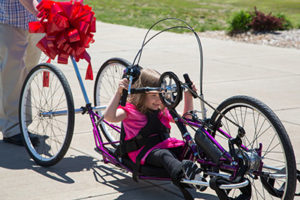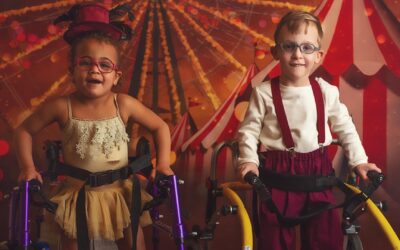Here are the top 10 benefits gained while riding an adaptive bicycle.
1. Crucial for physical and mental health
Exercise is crucial for overall health. Its benefits range beyond the physical positives of cardiovascular, strength, and bone/joint health but also include the mental health and good feeling that comes with exercise.
2. Healthy Body
Bike riding helps your body develop physically with bone growth, strengthening of anti-gravity muscles, development of hand/eye coordination and much more.
3. Fun way to exercise
For children with special needs, participating in an exercise program can be very difficult with commercially available equipment. Now available on the market are bicycles that have been designed to accommodate children with minimal to maximal postural support needs. They can be used as a stationary or an outdoors bicycle (even both).
4. Breathing and blood circulation
Bike riding helps contract and release of muscles helps to circulate blood and oxygen throughout the body for increased circulation and blood flow.
This also can be a component in a treatment plan for edema management if needed. Circulation and breathing are problem areas for many children with special needs; why not have fun and strengthen at the same time?
5. The digestive system and quality sleep
Exercise helps to keep the digestive system better regulated more regular and physical activity has been known to aid in better quality sleep and for longer durations.
6. Range of Motion
Riding a bicycle is a great way to work on range of motion. With the distractions of being outside it may be tolerated better as well. The benefits of being able to move easier throughout the range of motion are tremendous. It can make dressing, bathing, and toileting easier, potentially decrease pain, and assist with long term tone management.
7. Trunk Control & Balance
Riding a bicycle is a great way to increase tolerance for sitting upright. It is fun and engaging. This way is generally better tolerated than sitting on the edge of the mat/bed in the therapy gym or at home.
Additional endurance for sitting helps translate into better attention at school. As a child’s trunk and head control get better, the amount of energy used to maintain this posture lessens and makes it easier to concentrate on cognitive tasks. This can also carry over into better access for driving a power wheelchair, accessing a computer or communication device, or increased attention to the environment.
8. Cognitive Development
It is in a child’s nature to want to explore, have fun and generally just to have an unharnessed amount of curiosity about life and the world. Children begin to explore their environment and learn very early in life.
Movement is crucial for cognitive development. For children with special needs, this movement component may be more difficult. It is imperative that a child is offered some way to independently move and explore. It can be through a power wheelchair, self-propelled chair, scooting, bunny hop, crawling, rolling or by bicycle.
9. Visual Perception
Movement and cognition are linked hand in hand as are movement and hand-eye coordination/visual perception. One learns to perceive and visually process their surrounding through movement. For example, a child learns how close they are to the wall or table after bumping into it. Movement is so important for these higher level skills to develop to their full potential while adding significance to the environment and its lessons.
10. Social Acceptance
Social acceptance and emotional health are key to developing a positive sense of self. By being able to go out and ride a bicycle with peers and family members, a new group is opened up for a child and a sense of belonging emerges. They are able to participate in a “typical” activity with others.
Riding a bicycle is an age appropriate activity at all ages that is healthy throughout the lifespan and provides a sense of accomplishment, purpose and success for the rider. Adaptive bicycles are a wonderful addition for an active outdoors family, because it truly allows for everyone to be included.
All of these benefits serve to increase overall health and well-being while helping to develop a higher self-esteem. Finally, the American Academy of Pediatrics recommends an hour of aerobic exercise/activity each day for children!




